The delicious irony of Best Buy, a computer store that presumably uses Microsoft products, unable to sell Microsoft products because of “system software updates.”

At Crafting {:} a Life we spoke often of blogging. And when one speaks of blogging these days, one must speak of email newsletters.
Here’s where I’ve arrived, after thinking about this for the last week:
Blogging is something we do together; email newsletters are something we do by ourselves.
Both together and by ourselves are relative terms, and there’s leakage in both directions. But, for me at least, that’s the essential difference.
In 2017 Nell Bang-Jensen wrote down a set of guiding principles for her work, which includes:
Know everyone’s name. Name them over and over and over again.
This called to mind my Morgan/Joel Strategy that I outlined in 2017, and that I’ve been working to follow ever since.
Yesterday I was at a meeting of the Stars for Life board and, a few minutes after we got started, a person I’d never met walked down the stairs into the meeting room and took a place at the table. He wasn’t introduced to us, and nobody thought to ask who he was. As a result I thought there was a (remote) possibility that I was hallucinating.
Finally, after 20 minutes of meeting business, at a break in the proceedings, I looked his way and said “I’m afraid I don’t know who you are.”
At which point he was introduced as a new board member, someone we’d approved the appointment of at a previous meeting, sight-unseen. He knew almost everyone else at the meeting, which is why he wasn’t introduced.
I’m glad I said something, because it turned out that a couple of the other board members were also wondering who this interloper was.
Know everyone’s name. Name them over and over and over again.
Elmine (and watching we Canadians cycle) here in Canada. In part:
All in all my conclusion is that riding a bike safely in various parts in Canada is still a dream. From my Dutch perspective I seriously doubt if the places I visited ever will be able to be a dream places for cyclists. Canadian roads were designed for cars. It will take a tremendous effort to ‘un-design’ that. But it’s not just the roads that needs a redesign. It will take a generation to retrain everyone driving the road, both by car and on bike.
I think she’s right about the “retraining” that we need, but I think it applies not only to the practical skills related to safe and efficient bicycling, but also retraining our habits so that we shift all or most of our short-distance travel from driving to cycling.
Meanwhile, Oliver and I went out to West Covehead to look at a gently-used Tri-Rider this afternoon, and he took an immediate shine to it:
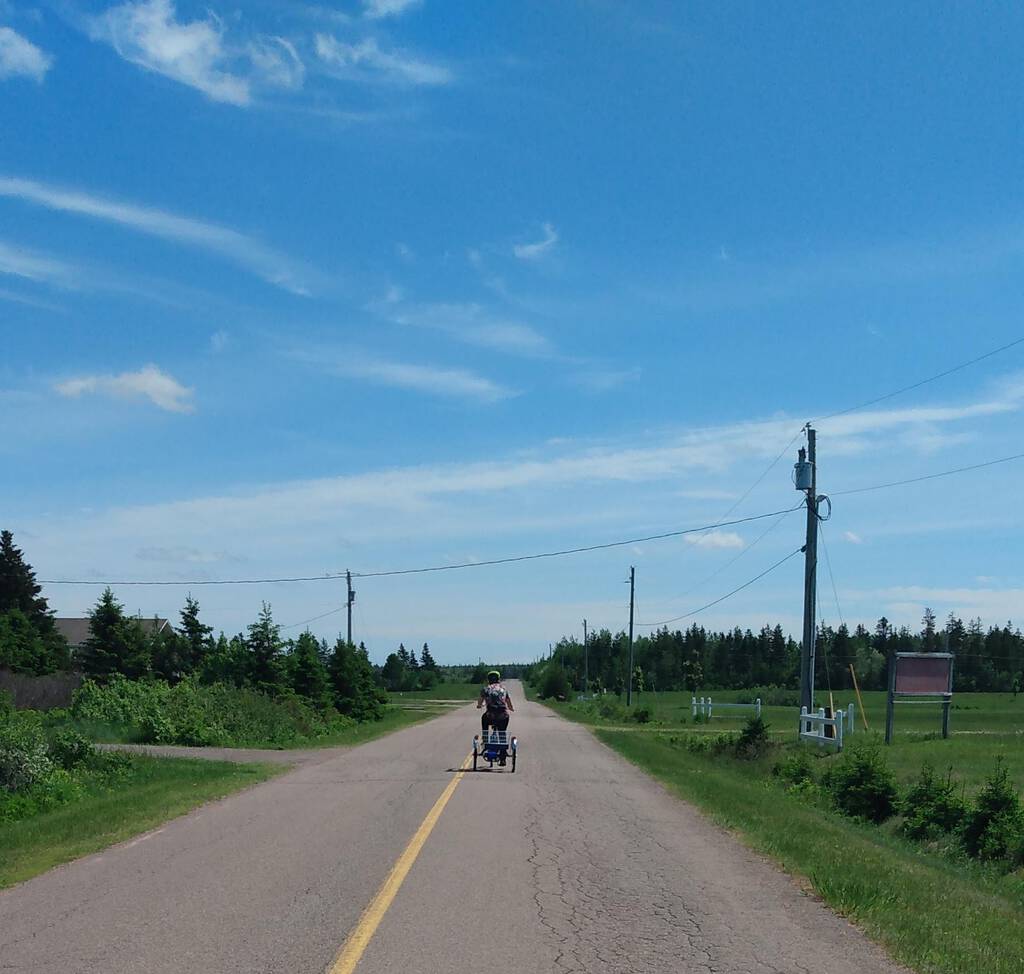
As anyone who’s driven or cycled in Charlottetown knows, we are blessed with north-south thoroughfares and have a scarcity of east-west ones.
This scarcity is even more apparent for cyclists wishing to use the Confederation Trail as the spine of the city: once you leave Belvedere Avenue heading north, alongside the University of PEI, there’s no clear route east or west until the Charlottetown Mall, making it more difficult to cycle to places on North River Road or onward to Lewis Point Park.
This is doubly-frustrating because there are already low-traffic roads or trails that go west into Lewis Point Park from the intersection of Enman Crescent and University Avenue: but there’s a kind of Darién Gap that separates the Confederation Trail from this, however, as illustrated by the red line on this map:
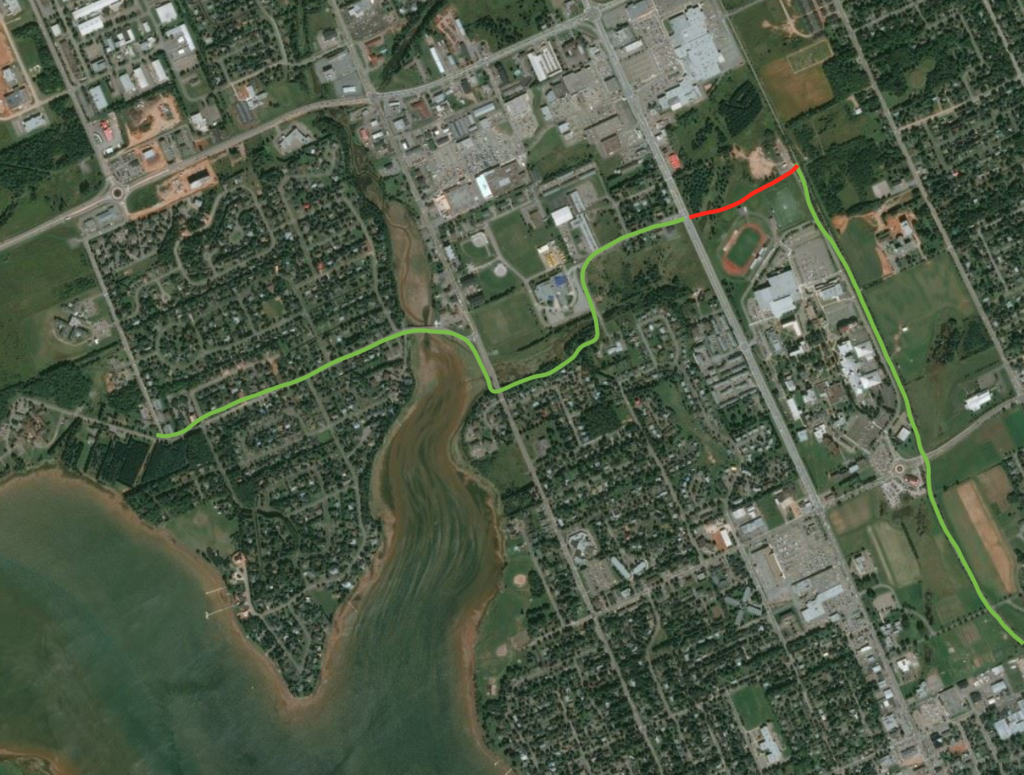
There are signs that this gap might be closed as the University of PEI carries out its master plan: the plan mentions the Confederation Trail and cycling in many different places (emphasis mine):
Confederation Trail is a cycling/pedestrian trail created from a converted rail line that runs the entire length of the Island dipping down to Charlottetown. Naturalized with stands of birch, poplar, spruce and tamarack, the trail forms the eastern edge of the campus and connects the University with downtown Charlottetown. Historically, trains stopped beside the campus and provided transit for students from across the Island. Today, the trail is used by cyclists, joggers, hikers and dog walkers.
Access to the trail should be improved to promote it as a direct, non-motorized route from the University to downtown, a route to the Charlottetown Mall or as a recreation corridor. Culverts that run parallel to the trail on either side collect water and foster naturalized vegetation buffers, but these culverts should be bridged at key locations to facilitate pedestrian access. Bicycle racks, shade pavilions and campus signage should be located at key points of entry into the University from the trail.
…
Walking and Cycling - the Campus Plan acknowledges the importance of pedestrian and cycling routes to the campus. Improvements include wider and safer sidewalks on University Avenue, clear connections from Confederation Trail to the Campus, more signalized crossings as well as designated bicycle routes and amenities on campus (e.g. sheltered and secure bike storage and access to showers).
…
Cycling still needs encouragement on campus.
…
Overall, the recommendations for pedestrian and bicycle circulation routes are:
- Pathway widths should be narrowed and rationalized to improve, define and separate pedestrian, vehicular and service vehicle traffic.
- A clear connection from the campus to Confederation Trail should be created.
- Improved connections to the north campus naturalized open space should be established to promote this area as a passive recreation district.
- Conflicts between vehicles and pedestrians, and vehicles and bicycles should be reduced.
- Bicycle parking areas should be improved in function and appearance
- Accessibility deficits should be improved upon or eliminated.
The “short range plan” for the campus includes a connector between the Confederation Trail and University Avenue through the area currently used as a maintenance yard and through to the pedestrian signals at the corner of University and Enman:
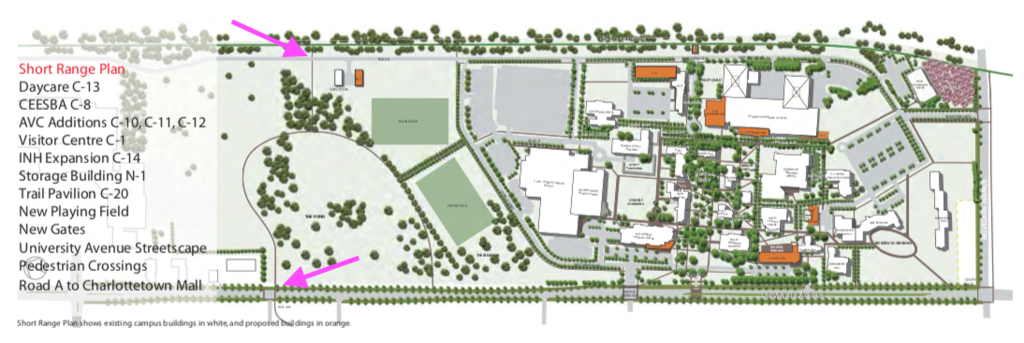
I set out this morning to see how far along this connector is, and I was pleasantly surprised by what I found: I was able to ride my bicycle on an almost-trail-like surface from the Confederation Trail clear through to University Avenue. The way was muddy in places, but the trees had been cleared, and the hills were gentle:
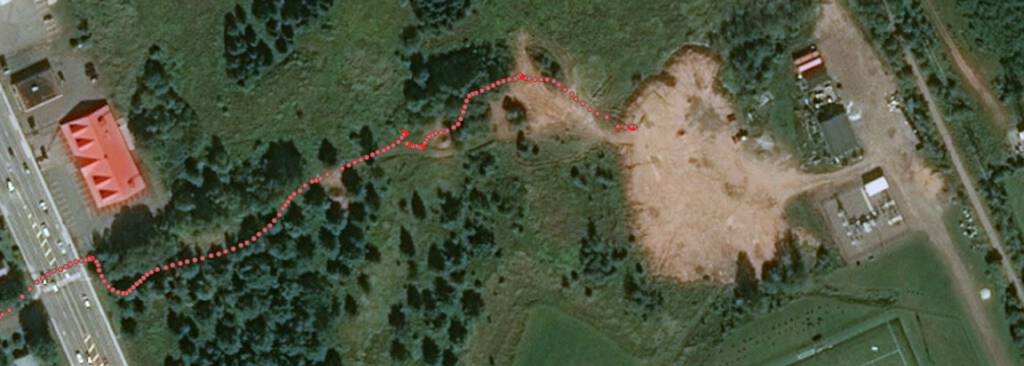
Once I rode to the edge of the UPEI maintenance yard there was what looked to be a relatively recently-cleared area that, while it’s a little soggy in the middle, was eminently navigable on a bicycle:
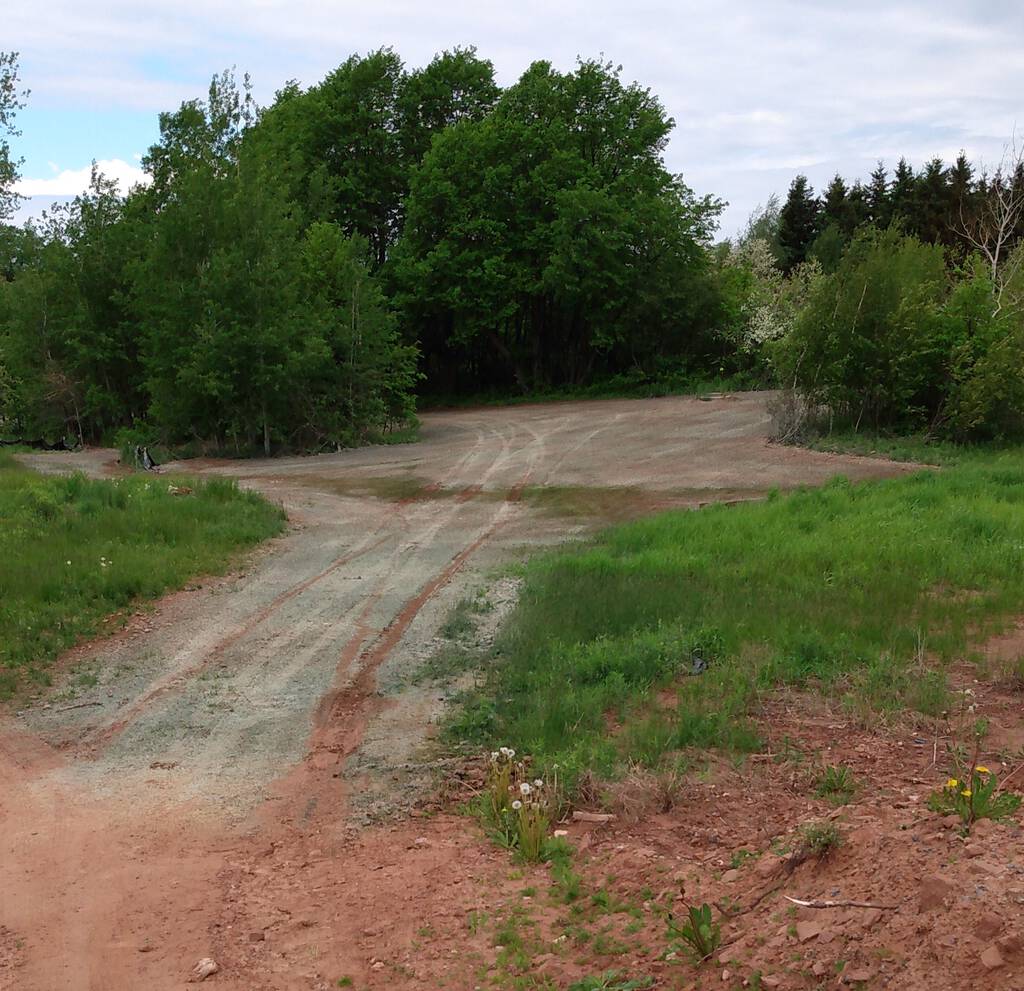
On the other side of this dip the clearing continues, and you can see clear on through to University Avenue:
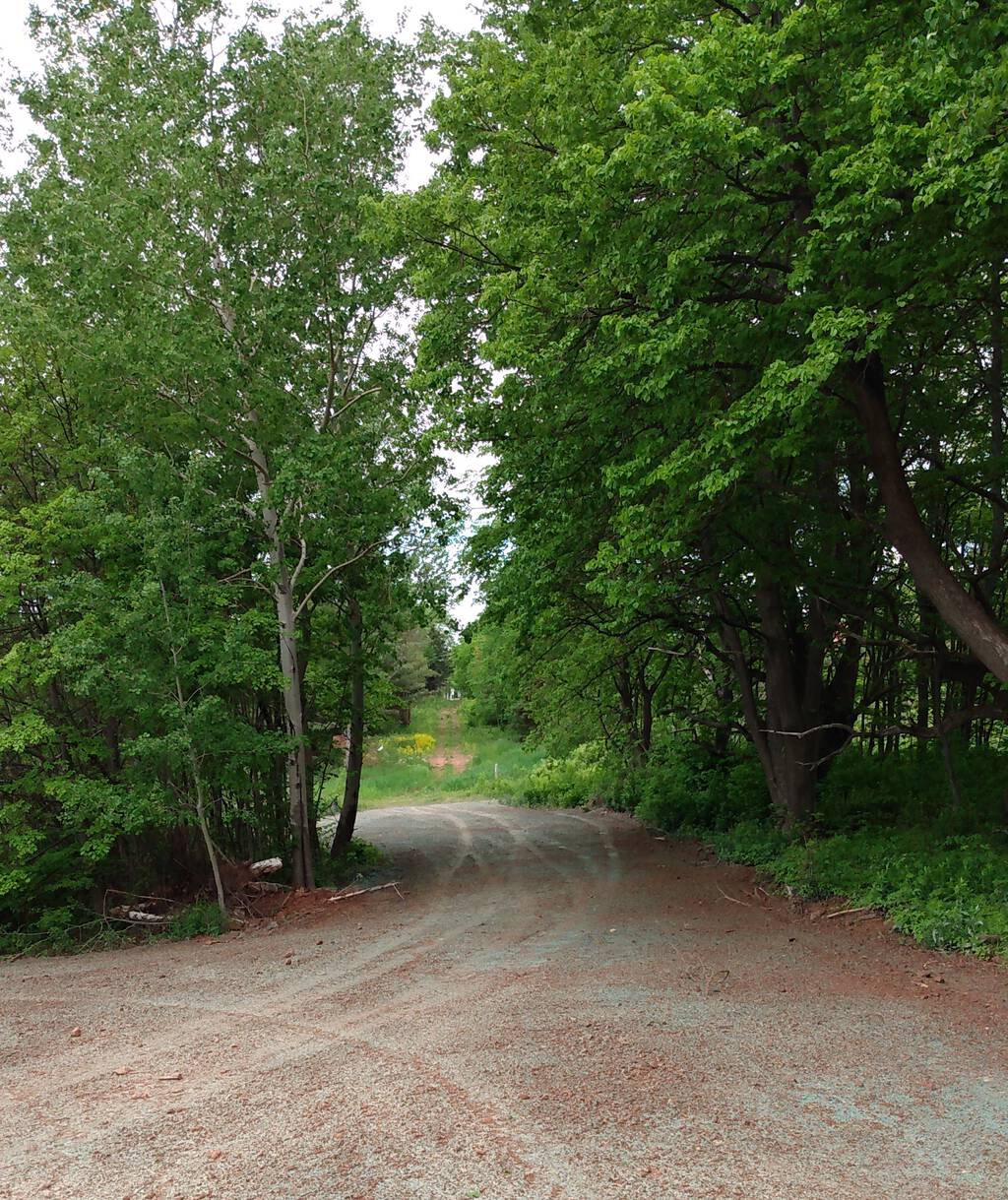
The track from the edge of the fully-cleared area up to University Avenue is a two-track almost-fully-trail-like path:
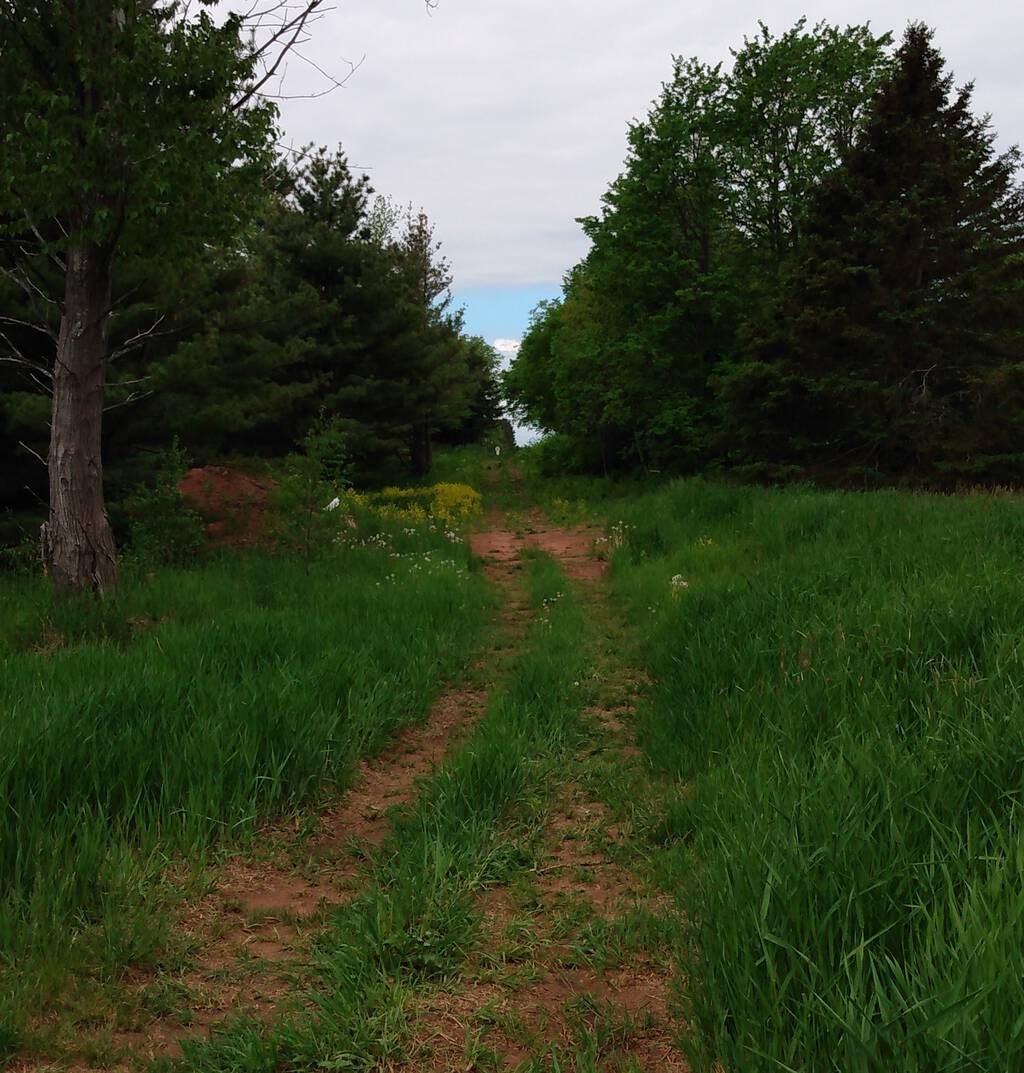
I emerged from this near the pedestrian signals crossing University over to Enman Crescent, and I could then continue along Enman, along Raiders Road to the Hermitage Creek Trail, which wends through the woods to North River Road:
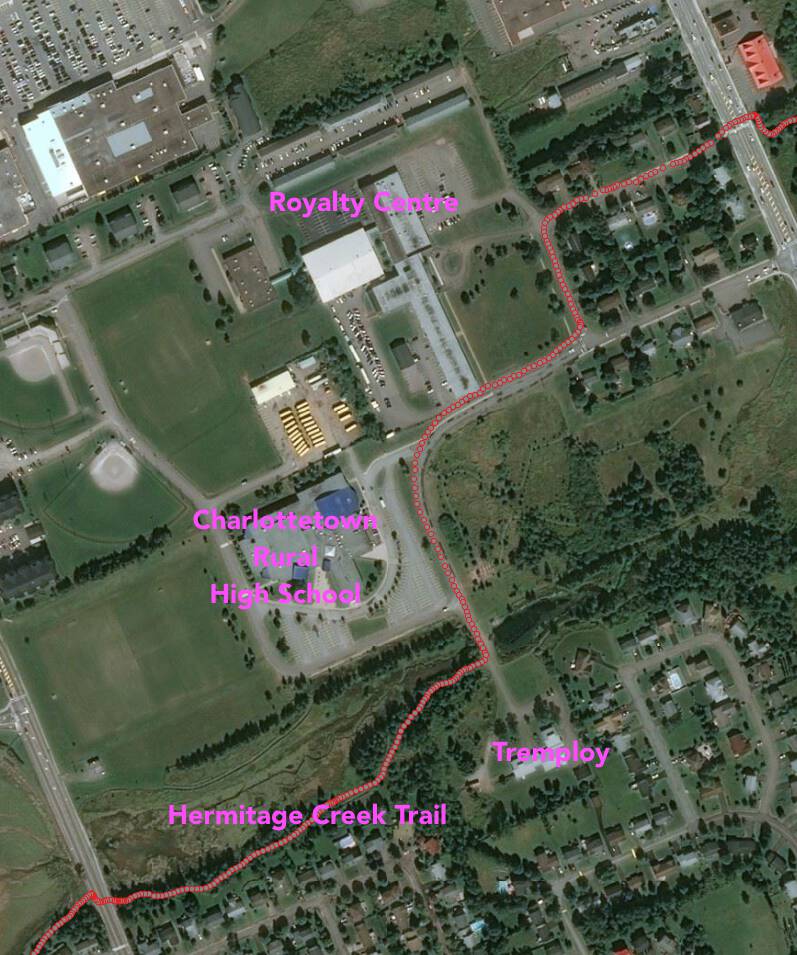
Once I reached North River Road, I was almost able to take trails or quiet streets clear on back downtown: there’s a nice riverside trail that continues on the other side of North River Road that, unfortunately, abruptly ends in an apartment complex parking lot, requiring a loop back up to North River Road. A little way down North River Road it looks like the trail picks up, but the way isn’t clear, and is blocked by felled trees; I could make my way to the cul-de-sac at the end of Madison Avenue by smashing through:

Once I reached Madison Avenue, I was able to cycle on back streets all the way to Victoria Park where I took the Victoria Park cycleway to Beaconsfield, and then continued downtown, a total journey of almost 10 km:

It’s encouraging to see the building blocks are in place for joining some established and well-maintained cycle routes together; if we’re going to be zero-carbon sooner than later, we’re going to conquer these gaps in the active transportation network, and now is the time to start the work.
Here’s the list of blogs I read.
You can see that list just by clicking on that link, and it will look something like this in your browser:

But you can also save that file, and load it into your RSS reader of choice, to import my list of RSS feeds into yours.
Last year I wrote about my OPML file, a machine-readable list of all the blogs I subscribe to, prompted by Ton’s musings about the possible return of the “blogroll.”
Since I wrote that post I’ve switched to using FreshRSS as my feedreader, and I had to switch the way that I export my OPML file.
Prompted again by Ton, this time in Show Me Your Feeds… I’ll Show You Mine, I’ve taken things a step further, and added an XSLT stylesheet, adapted from the one described here, and now the OPML file can be read both by machines and by humans, in a browser. This was as simple as adapting the XSLT file for my blogroll (you can see it here) and then adding a reference to the XSLT file in my OPML file:
<?xml version="1.0" encoding="UTF-8"?>
<?xml-stylesheet type="text/xsl" href="https://images.ruk.ca/opml/opml.xsl"?>
<opml version="2.0">
<head>
<title>Peter Rukavina's Blogroll</title>
<dateCreated>Sat, 15 Jun 2019 21:07:51</dateCreated>
</head>
You can do this too!
I’d forgotten that my late friend John Muir came to Prince Edward Island in 2003 to participate in our Zap Your PRAM conference: appropriately enough, we recorded the audio of John’s session.

As The Source (née Radio Shack) is in the death throes of its transition from a hobbiest-focused electronics retailer to a cell phone shop, I was happy to find EurekaTec, tucked away in a strip mall in Lower Sackville, Nova Scotia.
EurekaTec sells an impressive array of 3D filament (some of which they make in-house), as well as Raspberry Pi’s, Arduinos, and related accessories.
On my visit yesterday I picked up a carbon monoxide sensor, a spare DHT22 temperature and humidity sensor, an AA battery holder with cover and switch, a tiny breadboard, and an XTC 3D kit for smoothing out 3D printed models.
Yet another good thing to come out of Lower Sackville.

As I dropped various Europeans friends off in various places over the past two days, the minivan I’d rented for the journey became less and less appropriate for the size of our party, culminating me driving around Halifax alone in a vehicle that can carry seven people. Realizing that I had an empty van in Halifax that I could fill with something to take back to Prince Edward Island, I decided to take yesterday to visit the bicycle shops of Halifax, with an eye to perhaps acquiring an electric-assist bicycle.
I rode my first ebike in Montreal 9 years ago; it was really more an emoped than an ebike, but the underlying idea was the same: could I make more places more reachable without my car by replacing it with something that makes cycling slightly less athletic.
I returned to the idea last year when I test-rode an Evox electric bicycle here in Charlottetown. At that point, even though I loved the ride and could see the potential, the $3,199 price tag put me off, and the idea returned to the back of my mind.
Over the last year, however, there have been new, cheaper imported ebikes available, in the $1500-ish price range, and I wanted to get a sense of how they compared. As Charlottetown only has one (and a half) bicycle shops, my opportunities for shopping around here are limited, hence my Halifax tour.
The eBike Centre
The eBike Centre is located in deepest light-industrial Dartmouth and shares facilities with NewStar Marine, which sells boats. They didn’t have a lot of electric bicycles in stock; their sales floor was more taken up with electric scooters. But they did have a folding Emmo F7 that I could test drive, and salesperson Celina took me on a cook’s tour of the bike and its capabilities. Because it folds, the F7 is also referred to as their “RV bike,” as it’s frequently purchased by people with motor homes for its more compact size when folded.
The bike retails for $1,699 plus freight and assembly, placing it in the heart of the “cheaper ebikes” category, and it does, indeed, feel slightly-less-than-premium in its build quality and ride. Of course a folding bike is, in part, optimized for folding, with smaller wheels and a different kind of frame, so it’s naturally got a different feel. But the F7 felt sluggish and more tank-like than I was comfortable with, and even its folding was unsatisfyingly un-Brompton-like, as it doesn’t origami together in its folded state, and just flops around (“most people use a bungee cord,” Celina said).
I was limited in real world test drive experience, as I was just riding around the shop’s parking lot, but I think I got a good sense of the bike; it wasn’t for me.
Dragon Ebikes
On the opposite end of Dartmouth, in a similar-feeling light industrial area, I visited Dragon EBikes.
Unfortunately, although their website shows a good selection of ebikes and accessories, they didn’t have any electric bicycles in stock, and their focus seems to be more on four-wheeled scooters than on bicycles. A wasted drive.
Cyclesmith
Across the harbour in Halifax proper I visited Cyclesmith, which is a traditional bicycle shop with all the good things (selection, expertise, bikes in stock) and bad things (intimidating vibe, bicycles mounted on inaccessible stands where you can’t get a visceral sense for them) that brings with it.
Cyclesmith’s ebike offerings are, as you might expect from the aesthetic and focus, on the high end: they had 10 models in stock, with the cheapest one starting at $2,499 and models as expensive as $6,199. This put things out of my price range, and it didn’t seem worth it to try to penetrate the bike-culture-wall to see if I could test drive one, so I took a browse around, looking mostly at non-electric bicycles, and then moved on.
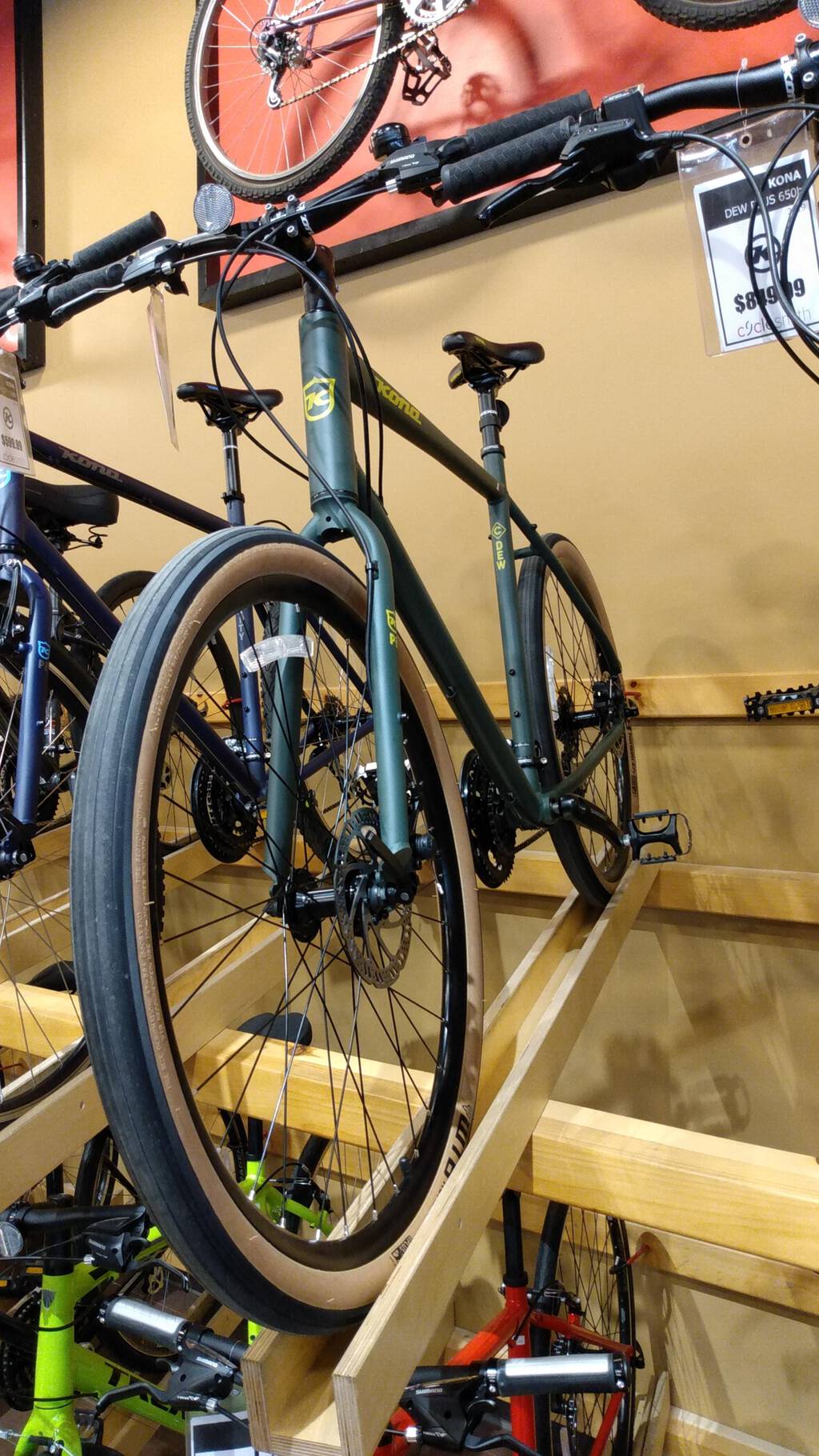
Robertson C Business Equipment
My Google Maps searches for “ebike” kept surfacing Robertson C Business Equipment in the results, and I’d been assuming this was some kind of SEO error. But it turns out that in addition to selling computers and point-of-sale systems, they also sell electric bicycles from the storefront next door, under the Halifax Electric Bike Store label.
This was certainly the weirdest bike shop I visited, and the one with the most genial staff.
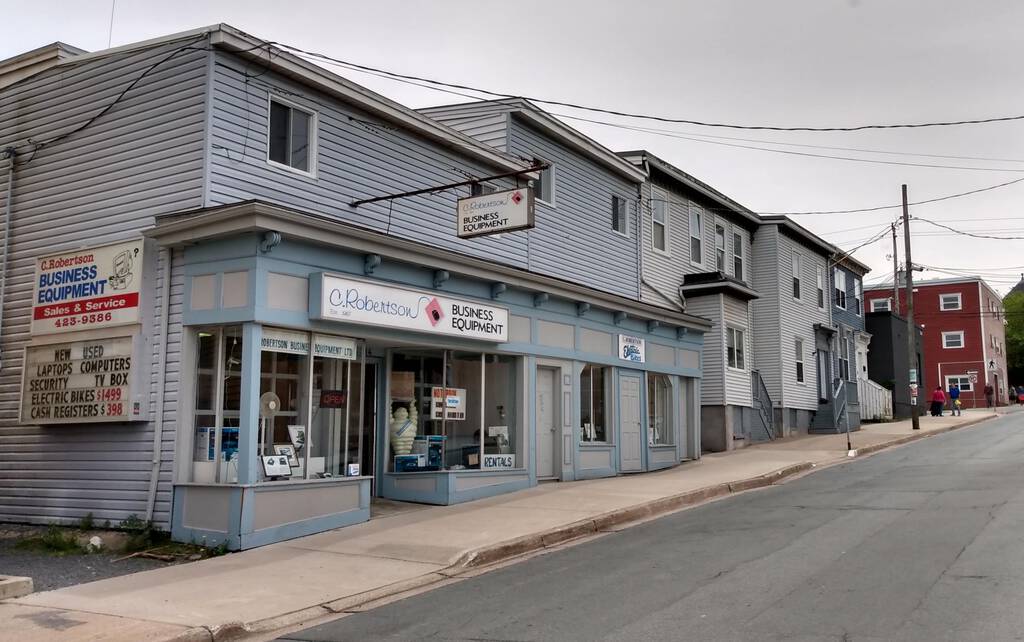
They had two models in stock, both from the Canadian iGO brand, the M29 and the Erö. I got a brief overview of the differences between the two (mostly styling and a difference in where the motor is located) and a recommendation that I try the M29 out on the road (“why don’t you take it up Citadel Hill to get a good test of how it handles,” it was suggested).
With a request to leave my wallet behind as collateral (a request that gave me no pause given the aforementioned geniality), I was given a helmet, a brief tutorial about how to use the bike, and sent on my way for an open-ended test ride. This is the way that testing should happen; the “no rush” is key, especially when dealing with things that cost multi-thousands of dollars.
I did as was suggested, and took off up Citadel Hill, enjoying Halifax’s considerably-better-than-Charlottetown bike lane infrastructure as I navigated around the neighbourhood.
The M29 was palpably different than the folding Emmo; some of this comes from the different form factor, but it’s also a much better-made bicycle, with a better, more responsive electric drive system. It was a joy to ride, and the pedal-assist felt sufficiently Superman-like on all but the steepest hill-climb (and even there, I didn’t sweat it to the top of Citadel Hill, I just had to pedal a little harder).
At $2,499 the M29 was still too rich for my blood, but I am happy to have test ridden it, and happy to have been able to do so outside of the confines of a mainline bicycle shop.
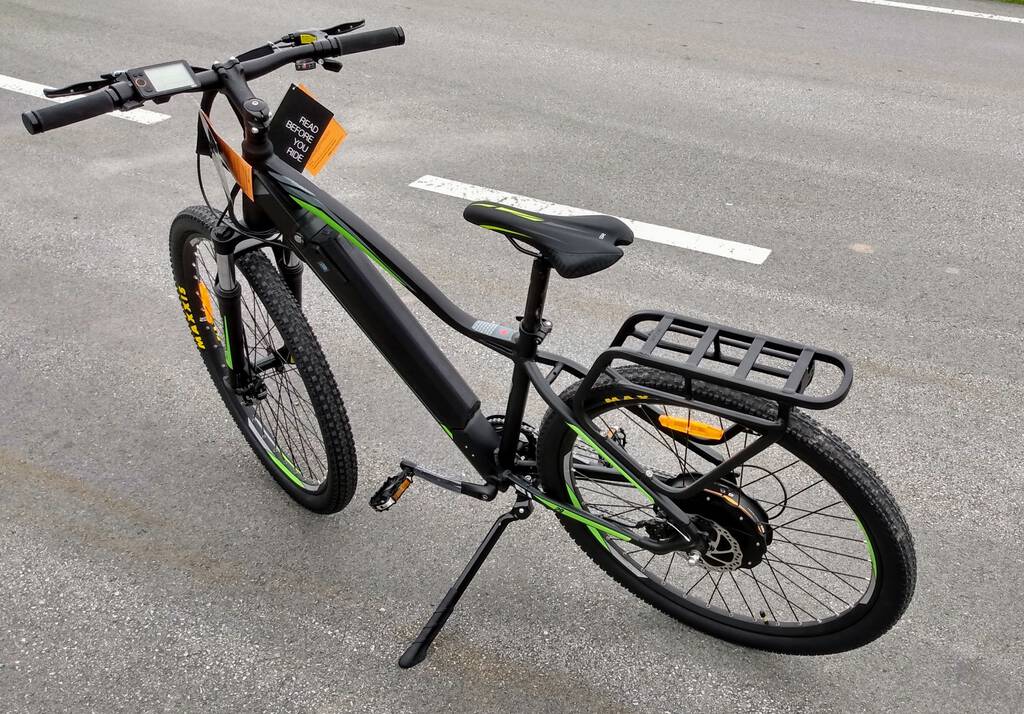
Sportwheels
My visit to Sportwheels, in Lower Sackville, was more about looking at adapted bicycles for Oliver than looking at ebikes, which was good, as they had only one ebike model on the floor.
While the shop is a straight-ahead bike shop (albeit with a significant hockey sideline), it was more workaday than elite, and I felt more comfortable there than I had at Cyclesmith.
I was referred to Sportwheels by the Recreation Therapy program at the IWK, and evidence suggests that they do a fair amount of business finding bicycles to suit people of all needs.
They didn’t have any adaptive bicycles in stock, but they were able to show me a Tri-rider, fitted with electric assist, that was a kind of hybrid between a standard trike and a recumbent. This seems promising, and like it might work for Oliver. It’s frustrating to not be able to have him try it out, however; it would be really great if PEI sported a program similar to the adapted bikes loan program at the IWK (perhaps that’s something Cycling PEI could take on?).

I didn’t buy an electric bicycle…
I returned home to Charlottetown with a empty van.
I decided that, as with the decision to insulate our house or purchase an electric car, the economics don’t make sense: I’m far better off, for now, continuing to ride the regular old Palomar that I’ve had for many years and to put my climate change-mitigation dollars into efforts that have a more substantial pay-off.
My tour of the bicycle shops of Halifax didn’t leave me with a lot of warm feelings about bicycle retailing in the 21st century: it appears to be a retail sector still very much rooted in sport rather than transportation, and for something that’s demands test riding to get a real feel for, the setup of shops isn’t optimized for this.
If my life was different and I was, say, commuting in to the city from Brookfield every morning, I’d certainly take a serious look at the iGO M29, as it would make a lot of sense for a longer-distance commute like this, and appears to have the build quality to stand up to daily use and the drive train to handle the varying terrain.

 I am
I am